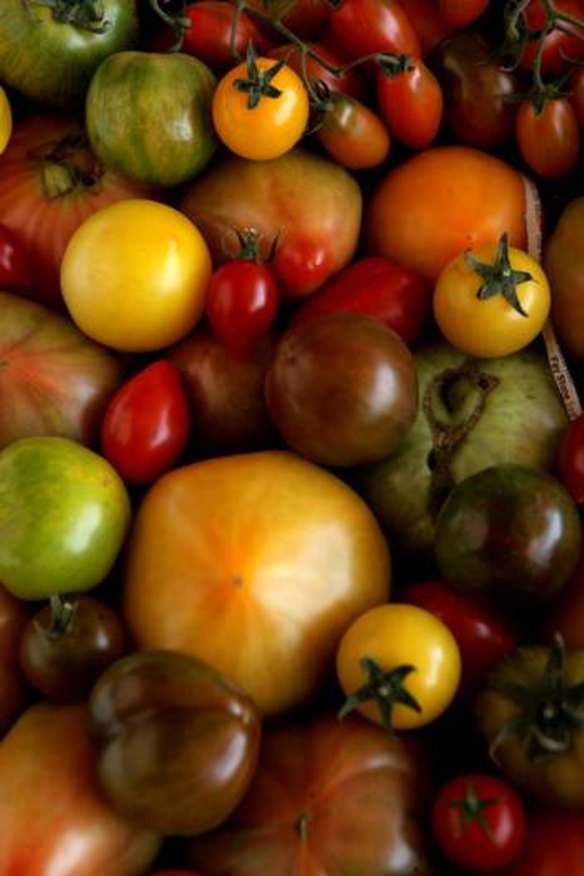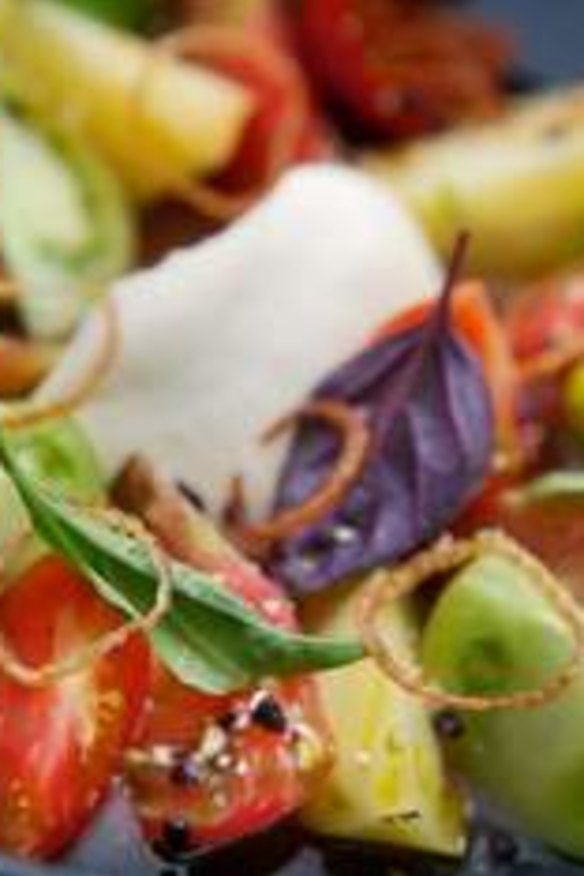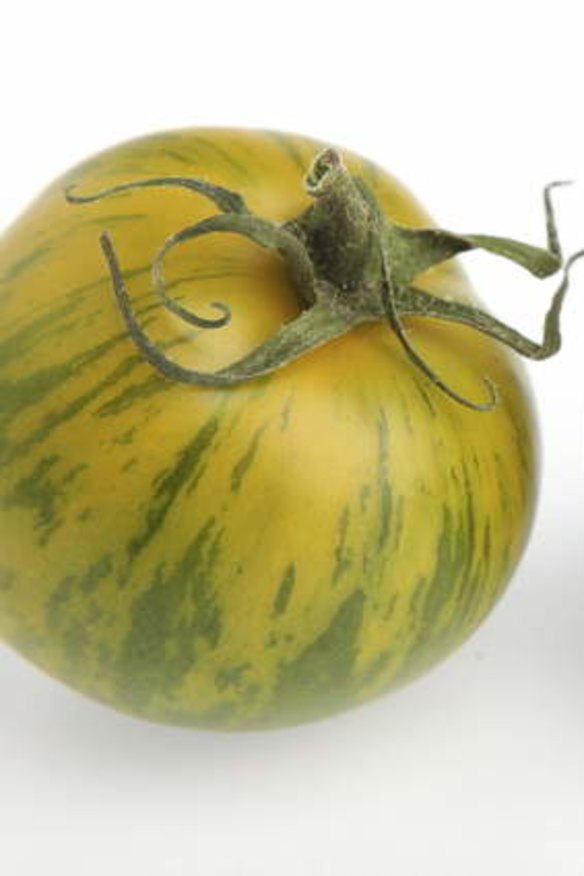You say tomato
New breeds of wild tomatoes are being created for flavour, not shelf life.

■ See an heirloom tomato recipe gallery here.
Squeeze a supermarket tomato in your fist and more than likely you will have to exert some force before the tomato splits. Modern tomatoes are bred for strength and shelf life, not flavour. This flies in the face of thousands of years of human intervention to create sweet, flavoursome fruit.
Wild tomatoes are native to Peru. Several thousand years ago they were transported north - perhaps by humans, perhaps as seeds in bird droppings - to what today is Mexico. These early tomatoes were weed-like and small, and the fruit split. The native Meso-Americans selectively bred the tomatoes into scores of different-shaped fruit, some as long as sausages, others as round as peaches, and in hues ranging from green to orange to deep purple.

When the Spanish conquistadors invaded in 1519, a foot soldier noted that human sacrifices were cooked in a sauce made from tomatoes, chillies, wild onions and salt.
Despite bringing tomatoes back from the New World, records show it wasn't the Spanish who first took the fruit into the kitchen but the Italians. In mid-1544 Siennese doctor Pietro Mattioli described the fruit as ''golden apples''. He wrote that it was fried in oil like an eggplant and eaten with salt and pepper. Mattioli mistakenly claimed the tomato was a member of the poisonous mandrake family, echoing the suspicions Europeans had for new foods from the New World.
The first written account of the tomato in Spain is from Gregorio de los Rio, a priest who worked in the botanic gardens south of Madrid. In 1595 he noted tomatoes were good in sauces, adding that Spaniards were already adopting the Mexican method of preparing the fruit, presumably without the sacrificial protein. By the early 1600s Seville's Hospital de Sangre - the ''blood'' hospital - was buying tomatoes from local farmers.

Contemporary Seville painter Bartolome Murillo's The Angels' Kitchen, now hanging in the Louvre, depicts cherubs pounding away at a mortar and pestle, red and yellow tomatoes at their feet.
Jews fleeing persecution in Spain in the mid-1700s took tomato recipes with them to England. At the time, tomatoes were planted in Britain mainly as ornamental plants. Tomatoes didn't catch on with the British until the early 1800s.
In the US, despite Thomas Jefferson growing tomatoes in his garden, the Americans were wary of eating them. A public display of tomato eating outside a courthouse in New Jersey in the 1820s convinced observers of their deliciousness and so America's love affair with the love apple began. America became a stronghold of tomato diversity, with home growers and seed companies developing myriad cultivars based on suitability to microclimates but also for flavour.
Ninety per cent of these cultivars were wiped out after the massive changes in food production and distribution after World War II. The construction of the interstate highway system and the rise of the supermarket created a demand for durable tomatoes that would survive the journey from where they were grown to other parts of the US, where they could sit on a supermarket shelf. To meet this demand, hybrid tomatoes were developed by the Agricultural Research Service and Davis University California in the 1950s.
These tomatoes were slow to ripen, had thick red skin and durable pulp - and they could last in a truck and on a supermarket shelf. The millennia of breeding for flavour was wiped out, replaced by a few almost flavourless hybrids.
One of these was a tomato called roma, itself based on the San Marzano tomato from near Naples, originally a gift from the people of Peru in the 1770s. While the San Marzano is sweet, soft skinned and rich in flavour, the modern roma struggles to fit any of those descriptions.
The pendulum, however, is swinging the other way. Professor Harry Klee from the University of Florida admits that, "over the years, much of the flavour has been lost from commercial varieties of tomato". He says "the taste of a tomato is the consequence of the interactions of sugars, acids and a set of 15 to 20 volatile compounds".
He is unlocking the secret of how these compounds interact with each other, and trying to breed flavour back into tomatoes using wild relatives of the domestic tomato, and the remaining cultivars that today we called heirloom tomatoes. Speaking to ABC Radio National's Science Show recently he added, "Anybody who has ever grown these heirloom [tomatoes] will tell you they are a pain to grow. They are susceptible to diseases, so we have to be able to improve the heirloom performance but maintain the flavour."
Professor Klee believes it is only a matter of three to four years before we see flavoursome and durable tomatoes in our supermarkets.
For now, those wanting more flavour from their tomatoes should seek out the heirloom varieties. These are tomatoes grown from the seeds of tomatoes popular mostly in the US and Britain and developed in the late 19th and early 20th century for particular conditions in particular locations. They are more prone to disease than the modern hybrids and more difficult to grow and secure fruit from. As a result, they became unpopular with commercial growers.
Damian Pike, respected stallholder at the Prahran Market, says, "These are the varieties that our grandfathers and their fathers grew.''
Pike is not a big fan of heirloom tomatoes from a commercial perspective. "At this time of the year customers who are interested in them are growing them themselves at home," he says. "And some of the commercial growers are treating them like hybrids - forcing them, so we end up with big, heavy, watery heirloom tomatoes with split skins." That said, he still carries mixed 500g packs of good quality Black and Green Zebra, Mamma Mia and Stella tomatoes for $6.
"We have tried many varieties of heirloom tomatoes and failed," says Jill McCalman of Glenora Heritage Produce, suppliers to some of Melbourne's best restaurants and farmers' markets. "Now we have our tried and tested varieties but they are still a bugger to get perfect."
One of her customers is Nic Poelaert, chef at Brooks in Melbourne. "I love the variety of aromas these tomatoes produce," he says. "They can be tropical, floral, sweet, sour, peppery." The difference from one variety to another is quite amazing." He is using the best tomatoes delivered from the farm and peeling and confiting them in olive oil, then serving them with chamomile cream and a mousse of frozen tomato syrup flavoured with basil.
Dave Verheul, at Town Mouse, is another fan of the heirloom tomato. He's currently serving them with tofu curd, fermented gazpacho, basil and sesame.
A recent taste test at Sydney Botanic Gardens, held by heirloom seed merchant Diggers Club, revealed a predilection for green-hued tomatoes. Green Grape, a recently introduced variety, scored 87.3 per cent favourability, compared with a supermarket tomato, which scored 41.6 per cent. Diggers founder Clive Blazey says, "Red is dead. Green is the new black."
Buyer's guide
These five varieties can be found in Melbourne's top kitchens, are at their best right now, and are available from Melbourne farmers' markets and selected greengrocers. Use heirloom tomatoes within a few days of purchase and expect to pay between $9 and $12 a kilogram.
1. Green Zebra
A green-and-yellow round tomato, with a bright, tangy taste, great for salad and perfect with goat's cheese.
2. Black from Tula
An intensely flavoured tomato sourced from Crimea that is chocolate-burgundy in colour with green shoulders. Great for salad.
3. Glenora Green
An as-yet-unidentified tomato grown from donated seed at Glenora Heritage Produce, it has a large yellow-and-green body, creamy texture, low acid and sweet flesh.
4. Stupice
Shaped like a large cherry, Stupice is deep red and great for oven drying and salad. It is intensely aromatic and sweet.
5. Rouge de Marmande
A large red tomato with fleshy ribs, it is full-flavoured with a firm texture. Good for salads and cooking.
The best recipes from Australia's leading chefs straight to your inbox.
Sign up